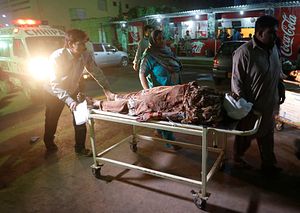On November 12, a terrorist attack struck a Sufi shrine in Pakistan’s volatile Balochistan province, which has resulted in the death of at least 50 people while more than 100 are reportedly injured.
This is the third major attack that has struck Balochistan in the period of three months. More than two months ago, an attack on the province’s lawyer’s community resulted in the death of more than 50 lawyers while about two weeks ago, more than 60 police cadets were killed when a police training academy was targeted in Quetta, Balochistan’s provincial capital.
The streak of suicide attacks in Balochistan points toward the complexity of the province’s militant problem, which appears to be aggravating just at the time when the country’s leadership needs to express control and calm. The illusion of slowly building peace in the province appears to be shattering, with sectarian and other jihadi militant groups wreaking havoc and terrorizing the province at will even after the state’s two-year-long brutal campaign to contain militancy in Pakistan.
The recent terrorist attacks in Balochistan have both internal and external connotations. Domestically, the state’s decades long policy of sheltering and legitimizing jihadist narratives has come back to haunt Pakistan. A number of militant groups that at one point were allied with the state are now being targeted.
What is further problematic, however, is these groups’ ability to strike the country in case their perceived utility for the state became outdated. Pakistan has experienced this phenomenon since 9/11, when the country began to target a number of militant groups that it had supported and legitimized previously. Now, however, the threat level in this regard appears to be rising, for the country has at some level begun to take on sectarian groups. But the challenge in this case in unique: unlike the Taliban, who were based in the country’s frontier areas, sectarian groups have a deeper reach and following in mainland Pakistan. Pakistan’s province of Punjab is dense with anti-Shia sectarian parties and militant groups which also operate a chain of madrasas (religious schools).
As I wrote earlier in The Diplomat, the state continues to remain in denial about the growing presence of the Islamic State (ISIS) in the country. Yet the attack on a Sufi shrine, which took place a few days ago, and the previous two attacks that targeted the province’s capital, were claimed either directly by ISIS or local sectarian militants associated with the group.
The Lashkar-e-Jhangvi (LeJ), which is likely the group behind the latest shrine attack – the group also took responsibility for the attack on the police academy a few weeks ago – has remained allied with ISIS for quite some time. LeJ and other sectarian groups such as the Ahle Sunnat Wal Jamaat (ASWJ) have been operating in Balochistan for more than a decade now. In order to maximize their militant capabilities in the face of the Army’s military action against them, these groups, in the near future, might form an alliance with Baloch militant groups against the state. Such an unlikely nexus cannot be ruled out entirely where both fronts stand to gain against the state
It’s worrying that sectarian militant groups continue to grow their foothold in Balochistan province. Traditionally, the state has tolerated these groups’ activities in the province largely due to their ability to neutralize Baloch nationalist groups. However, this policy has come at the cost of number of Muslim minority groups, such as Hazaras, who have been intimidated and terrorized for decades in the province.
On the external front, the recent bombings in Balochistan are likely to reinforce Pakistan’s belief that the rising unrest in the province is backed by the country’s enemies to derail and hinder the China-Pakistan Economic Corridor (CPEC), an economic project that promises to invest billions of dollars in Pakistan.
For the leadership in Islamabad, the recent terrorist incidents in Balochistan indicate that New Dehli and Kabul are willing to give Pakistan a taste of its own medicine. About two months ago, the Indian prime minister, in what appeared to be a response to Pakistan’s growing involvement in Jammu and Kashmir, hinted at assisting Baloch separatists if Islamabad didn’t stop its interference in the region. Analysts argue that even if India is involved in inflaming insurgency in Balochistan it is because of Pakistan’s involvement in Kashmir for similar purposes and India is just returning the favor by playing a tit-for-tat spy game with Islamabad.
Nonetheless, it is important to note that while Balochistan has experienced violence and unrest since Pakistan’s inception, none of the last three major attacks point toward the province’s secessionist movement, which is generally associated with the Baloch Liberation Army (BLA), Baloch Liberation Movement (BLM), Baloch Resistance Army (BRA), Baloch Liberation Front (BLF), and other like minded groups. These groups have generally targeted state installations rather than civilian infrastructure such as public places, markets, and shrines. By and large, the groups involved in Balochistan’s recent bombings found their motivations in the state’s internal workings rather than external geopolitics.
In Balochistan, not only are sectarian militant groups are strengthening their position, but other insurgent groups too are expanding their influence. It’s time that the leadership in Pakistan put its own house in order, for the blame game will not resolve the country’s deepening militant problem.

































